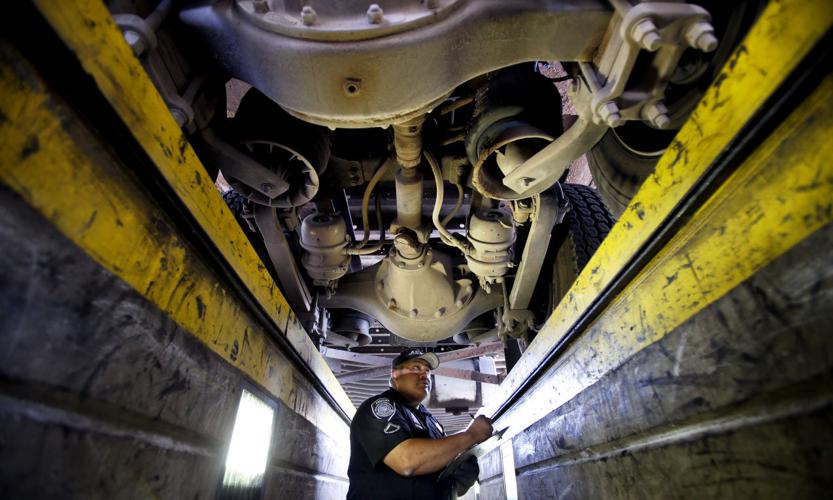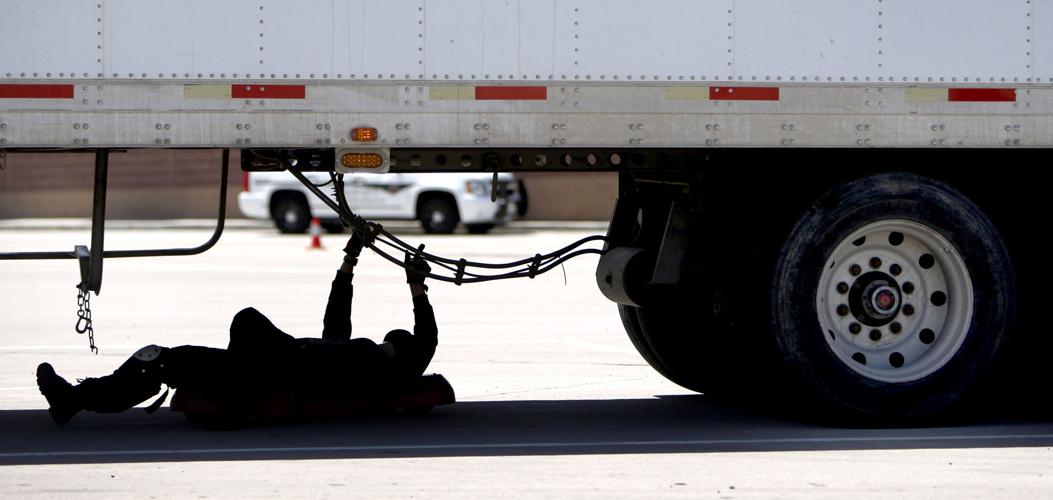The presence of federal transportation inspectors at Arizona’s international ports of entry continues to put the state at a disadvantage when competing for the billions of dollars in trade between Mexico and the United States, officials say.
“It makes us less competitive, especially Nogales, over other ports of entry like McAllen, Laredo and Tijuana,” said Alejandro Andrade, president of the Nogales-based Safe Border Trucking Association.
“Right now we have 17 (federal) inspectors here. In Otay Mesa, in California, they have zero. The inefficiency this produces and the cost it represents for Nogales exporters and importers is significant,” he said.
At the heart of complaints by the trucking industry in Ambos Nogales is the number of level one inspections — a complete check of both the driver and equipment — that Federal Motor Carrier Safety Administration personnel carry out.
Last year, a protest blockade at the Mariposa Port of Entry by Mexican drivers was narrowly avoided when state and federal officials came together with industry representatives to address those issues.
Since then, the state has asked the FMCSA to allow inspectors from the Arizona Department of Transportation to handle all level one inspections at the ports of entry, in keeping with how things are done in other states.
So far, the federal government has had no response.
Arizona’s international ports of entry have had a disproportionately high number of level one inspections, along with fines and out-of-service orders, when compared to ports in Texas and California, state transportation officials say.
This seems to be the result of the different working conditions that exist in Arizona, said Allison Moore, who is with the Fresh Produce Association of the Americas.
“In other states you don’t have FMCSA sitting right at the border when trucks come in. That is part of what’s happening, that’s part of why we see more inspections,” she said. “In other states they don’t have quite the captive audience.”
When the North American Free Trade Agreement was ratified 20 years ago, Arizona lacked both the infrastructure on the ground and the trained personnel to safely inspect every truck entering from Mexico, ADOT Director John Halikowski wrote in a letter to FMCSA.
Since then the situation has changed and Arizona now has state-of-the-art inspection facilities, officials said, yet federal inspectors continue to work at the ports.
Safety first
During produce season, which runs from December through June, the Mariposa Port of Entry in Nogales averages about 1,500 trucks per day, with as many as 1,800 coming through sometimes, said Lt. Joseph DoPadre with ADOT’s Enforcement and Compliance Division.
After those trucks go through inspection by Customs and Border Protection officers, they must pass through the Department of Transportation’s rapid express lanes, where the truck is quickly scanned.
From a booth at the head of the lane, an ADOT officer looking at a monitor can see a vehicle’s registration, its weight and measures and whether it has or needs special permits.
“If we determine the truck doesn’t have a proper permit, or is overweight or something like that, then we send that truck back,” DoPadre said.
ADOT inspectors share the booth with their federal counterparts and either of them can request that a truck be sent back for additional inspection, based on their opinion.
For the trucking and produce industry, this is where federal inspectors are hurting business.
“The state doesn’t do as many level one inspections, where even a hairline crack is enough to put you out of service, having to pay $200 for a tow truck and up to a $3,500 fine,” Andrade said.
Like Andrade, the produce association’s Moore said that while safety is paramount, discretion should be used when requesting additional inspections.
“We’re advocating for smarter targeting on where you’re doing your inspections. It’s not just, ‘that truck is next’ or ‘we have three people that need to do an inspection so let’s grab the next three trucks,’” Moore said.
While FMCSA recognizes the need for efficient freight movement, its goal is to ensure that every vehicle entering the United States is safe, the agency said in a statement.
“FMCSA’s congressional mandate necessitates our agency’s presence on the border to ensure highway safety. The traffic inspection needs and associated resource requirements are different not only in each state but at each port of entry as well,” officials said.
Getting better
ADOT officials said that while making sure trucks are safe to drive is their primary focus, they are conscious of the industry’s significance to the community.
“The folks here, this is their life. This is how a lot of people are employed, and if it’s affected, if trucks go to different areas, people lose jobs, people lose homes,” said DoPadre. “We take that seriously.”
Two years ago the Arizona Department of Transportation began hosting a truck rodeo at the Mariposa port as an outreach effort to educate carriers about what inspectors look for and how they can keep trucks on the road.
“We meet with industry and we look at all of these components in a very relaxed but professional environment. We can show, we can demonstrate, and they can make comments and ask questions,” said Tim Lane, chief of enforcement services for ADOT’s Enforcement and Compliance Division.
Lane said these outreach efforts represent the importance Arizona places on international trade and its relationship with Mexico.
“It shows how valuable that relationship is, how valuable these drivers and all the industry representatives are to us. They’re more to us than just a truck crossing the border,” he said.
Officials at the Mariposa port said that not only have the education efforts cut down on the number of violations, they also have sped up traffic as drivers know what’s expected of them.
But while the industry has a good relationship with ADOT, it wasn’t until the proposed blockade in 2014 that the FMCSA came to the table.
“Before that there was no communication,” said Andrade. “Since we started having meetings they have been very open, no doubt that they’re working with us, but there are still things that haven’t been corrected.”
Although the state is still waiting for a response from FMCSA, the agency said in a statement that it continues to evaluate its presence at each border crossing and is always willing to consider programmatic adjustments that enhance the overall safety of commercial vehicles.
The goal of industry and state lobbying before the federal agency is to eliminate what amounts to an unfair trade barrier for Arizona, said the fresh produce industry’s Moore.
“We should be leveraging the efforts that the state is already doing,” she said. “Why not recognize that work instead of the state doing an inspection today and then maybe the feds do an inspection two days from now?”





